Related Research Articles

Sir Hubert Ferdinand Opperman, OBE, referred to as Oppy by Australian and French crowds, was an Australian cyclist and politician, whose endurance cycling feats in the 1920s and 1930s earned him international acclaim.
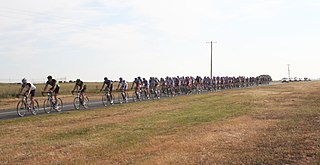
The Melbourne to Warrnambool Classic cycling race is a one-day road bicycle race. The race started in 1895 and is Australia's oldest one day race and the world's second oldest one day race, after the Liège–Bastogne–Liège Classic. Historically until 1938 the race started in Warrnambool and finished 165 miles (266 km) later in Melbourne. In 1895 the race was run in the opposite direction, from Melbourne to Warrnambool and then again from 1939. The route started in the Melbourne central business district and followed the Princes Highway to Warrnambool on Victoria's western coast. This traditional route was the longest race on the Union Cycliste Internationale (UCI) calendar, the exact distance varying slightly over time.

The Australian National Road Race Championships, are held annually with an event for each category of bicycle rider: Men, Women & under 23 riders. The event also includes the Australian National Time Trial Championships since 2002. The Australian Championships were officially known as the Scody Australian Open Road Cycling Championships from 1999 to 2010, taking the name of their main sponsor. This changed to the Mars Cycling Australia Road National Championships from 2011 but they are more commonly referred to as The Nationals. The under 23 championships were introduced in 2001. Note that these results do not currently include the senior and junior amateur road race championships that were held prior to the open era.

Nino Borsari was an Italian cyclist who won a gold medal in the 4000 metres team pursuit event at the 1932 Summer Olympics.

Richard William "Fatty" Lamb was an Australian racing cyclist who competed on both road and track, as was typical of Australian cyclists of the era such as Hubert Opperman. Throughout his career, Lamb was associated with Malvern Star Bicycles and Bruce Small.
Alby Barlow was an Australian racing cyclist from 1935 who rode for Oakleigh. In 1947 he was the Australian 100 miles road champion and holder of the 25, 50 and 100 miles Australian unpaced road records.
Keith Rowley (1919–1982) was an Australian racing cyclist.

Oserick Bernard "Ossie" Nicholson was an Australian cyclist who twice held the World Endurance record for distance in a calendar year.
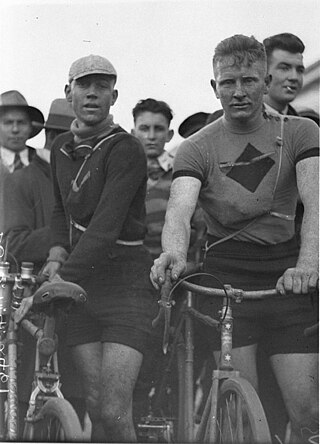
Ernest Milliken was an Australian Road racing cyclist who performed strongly in distance races and individual time trials.
Walter "Hefty" Stuart (1912–1938) was an Australian cyclist who competed on both road and track, as was typical of Australian cyclists of the era such as Hubert Opperman and Richard Lamb.
Max Rowley was an Australian racing cyclist.
Ernest "Ernie" Bainbridge (1890–1984), also known as Ern Bainbridge, was an Australian racing cyclist, who is best known for competing in the 1928 Tour de France with fellow Australian Percy Osborn and Hubert Opperman and New Zealander Harry Watson.
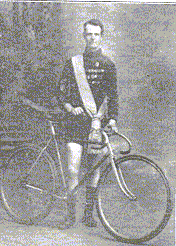
Duncan "Don" Kirkham was an Australian racing cyclist. Kirkham was a regular competitor in Australian long distance cycling races. He won the Goulburn to Sydney Classic in 1910, riding off scratch and setting the fastest time. In 1911 he was 2nd and set the fastest time, riding the 131 miles (211 km) in a record time of 6h 19' 31". Kirkham's time was not beaten until 1925 by Richard "Fatty" Lamb. He had previously finished 5th in 1909. and finished outside the top 20 in 1912.
John Beasley was an Australian racing cyclist and rode in the 1952 and 1955 Tour de France.
Percy Osborn (1901-1991) was an Australian racing cyclist.
Alan "Pete" Angus (1912–1988) was an Australian racing cyclist.
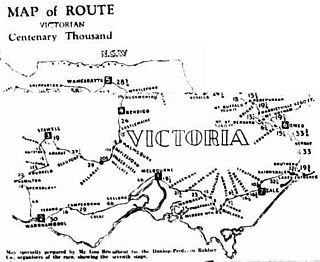
The Centenary 1000 cycling race was a one-week road bicycle race over seven stages covering 1,102 miles (1,773 km). The race was run in 1934 as part of the celebrations of the Centenary of Victoria. The race was originally conceived along the lines of the Dunlop Grand Prix, won by Hubert Opperman then aged 23, by 1h 20' and the concept for the race was covering 1,000 miles (1,600 km) with prizes exceeding £1,000, including a climb over Mount Hotham.
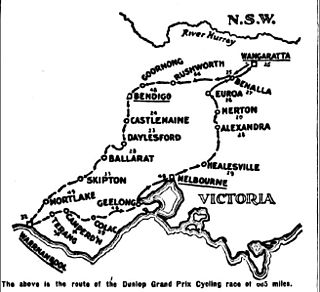
The Dunlop Grand Prix was, in 1927, the biggest cycling race in the British Empire and the richest race in the world. It was organised by the Dunlop Rubber Company which had a long history of organising bicycle races, including the Warrnambool to Melbourne, Colac to Melbourne and Goulburn to Sydney. As a result of the Dunlop Grand Prix, the Warrnambool was not held in 1927 however the Colac and Goulburn races were.

Jean Bidot was a French professional cyclist from 1926 to 1939 and was nicknamed the "Strategist". Winner of the Criterium des Aiglons in 1926, aged 21, he won the Circuit de Paris in 1928. In 1929 he was second in the French national road championship behind his brother Marcel. In 1930 traveled to Australia, finishing 3rd in the Sydney to Melbourne and the Tour of Tasmania.In 1931 he won Paris-Belfort and Paris-Vichy, a race he won again in 1932, along with Paris-Angers. In 1933, he won the circuit of Deux-Sèvres. Bidot won the Tour de Vaucluse in 1934 and 1935. He managed the French team in 1950 and 1951.
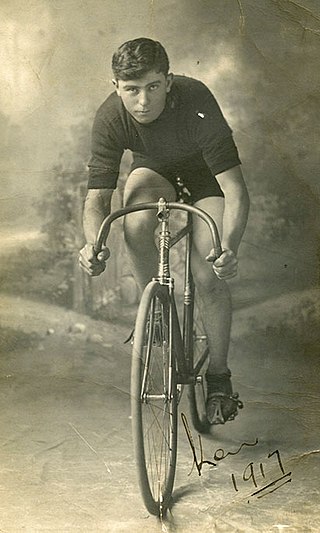
Ken Gordon Ferndale Ross (1900–1974) was an Australian road and track cyclist. His best results were achieved in the Goulburn to Sydney, where he set the fastest time on three occasions and in the Sydney Six-day race which he won three times.
References
- ↑ Event registration number 8297 (1906) Births Deaths & Marriages Victoria
- 1 2 "Thomas Fastest". Cycling and Motor. The Sporting Globe . Melbourne: National Library of Australia. 11 September 1929. p. 11.
- 1 2 "In battle of wits". Cycling and Motor. The Sporting Globe . Melbourne: National Library of Australia. 29 October 1930. p. 12.
- 1 2 "Cycling". The Sydney Morning Herald . National Library of Australia. 15 September 1930. p. 14.
- 1 2 "25ème Tour de France 1931" (in French). Memoire du cyclisme. Archived from the original on 6 March 2012. Retrieved 29 September 2009.
- 1 2 "Six Days' Race". The Sydney Morning Herald . National Library of Australia. 15 August 1932. p. 13.
- 1 2 "Thomas Rides Brilliantly For Fastest Time". The Sporting Globe . Melbourne, Vic.: National Library of Australia. 24 September 1932. p. 4.
- 1 2 "Brilliance of Thomas". The Referee . Sydney, NSW: National Library of Australia. 3 August 1933. p. 14.
- 1 2 "Humphreys and McKenzie Win". Cycling. The Sporting Globe . Melbourne: National Library of Australia. 20 September 1933. p. 12.
- 1 2 "Neck and neck struggle". Cycling. The Sporting Globe . Melbourne: National Library of Australia. 8 November 1933. p. 12.
- 1 2 ""Gippsland" comes to NS Wales". The Referee . Sydney: National Library of Australia. 8 October 1936. p. 18.
- ↑ "Dashing Thomas". The Sporting Globe . Melbourne: National Library of Australia. 12 June 1929. p. 10.
- ↑ "Advertising". The Sporting Globe . Melbourne: National Library of Australia. 1 May 1929. p. 11.
- ↑ "Australian Cycling 30 October 1930". Reprinted in The Cycling Scrapbook. Retrieved 30 May 2015.
- ↑ "First Blood to Oppy". Cycling and Motor. The Sporting Globe . Melbourne: National Library of Australia. 22 October 1930. p. 11.
- ↑ "Tour de France". The Argus . Melbourne: National Library of Australia. 4 July 1931. p. 21.
- ↑ "Case of Frank Thomas". The Referee . Sydney: National Library of Australia. 16 January 1936. p. 19.